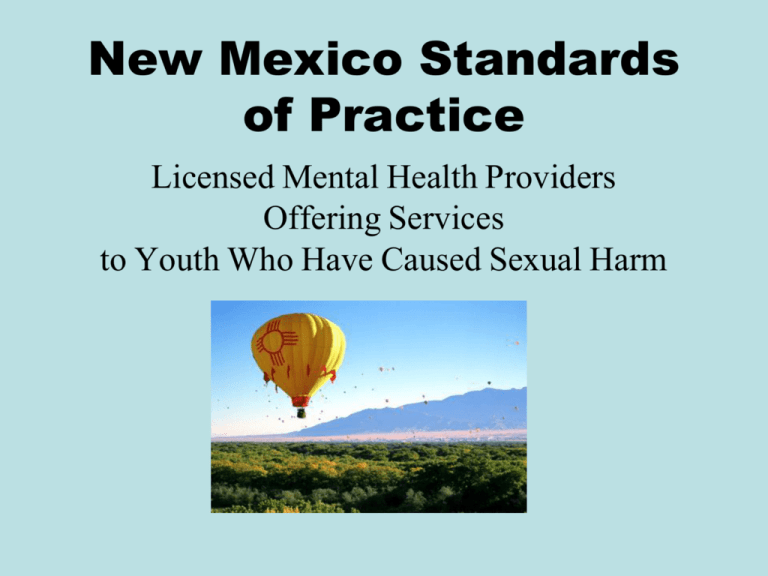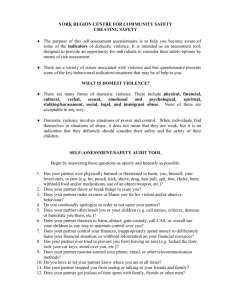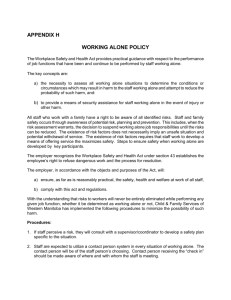
New Mexico Standards
of Practice
Licensed Mental Health Providers
Offering Services
to Youth Who Have Caused Sexual Harm
Credits
New Mexico Standards
for Assessing And Treating
Youth Who Have Caused Sexual Harm
are adapted in part from
Community-Based Standards
for Addressing Sexual Harm by Youth
(Schladale, Langan, Barnett, Nunez, Fredericks, Moylan-Trigiano & Brown, 2007)
Credits
•
•
•
•
•
•
Randall Cherry, J.D.
Steve Johnson, L.P.C.C.
Jill Ryan, Psy.D.
Joann Schladale, L.M.F.T.
Peter Vance, L.P.C.C.
Members, Alliance to Prevent Sexual Harm by Youth
(APSHY)
Purpose of Standards
•
•
•
•
•
Best practice standard for assessment and treatment of
youth
Provide a template for a comprehensive response
Focus on protective factors that increase overall health
decreases the risk for harmful behavior
Knowledge about how to identify and manage/eliminate
the risk
Recommendations for specialized training and
supervision
Approved by SOMB and NM
Sentencing Commission
• A task force of New Mexican professionals
collaborated to create these Standards
• Latest research and evidence-based practices
• Standards will be continuously evaluated for
accuracy and effectiveness
• Comments can be submitted to New Mexico
SOMB and APSHY
Guiding Principles
• Do no harm: All services are provided in the
least restrictive setting for all involved in a
manner that does not cause harm or injustice to
any party
• Every member of a community deserves to
be safe: Victims or potential victims as well as
youth who have caused sexual harm must be
physically and emotional safe
Guiding Principles
• Sexual harm hurts people: Concern for victims and their need
for respect, healing, empowerment, and ongoing safety must
remain the driving force of care
• Individualized treatment begins with a thorough
assessment that is ongoing and identifies:
– risk factors
– protective factors
– co-occurring behavioral/ mental health disorders
– the community’s strengths
– resources and challenges
Guiding Principles
• Assessment and treatment are culturally
sensitive: Respect for gender, race, ethnicity,
sexual orientation, religion, nationality, culture,
family structure, financial status, etc.
Guiding Principles
• Co-occurring Serious Mental Illness must be
identified and treated:
– General functioning, psychological, and psychiatric
assessments
– Specific assessment of sexual behavior issues make
prioritization of treatment needs possible
– Risks associated with psychiatric disorders can be
greatly moderated with effective treatment or can
significantly increase risk if untreated or
undertreated
Guiding Principles
• Family focus is central to a treatment
process aimed at reducing and eliminating
sexual harm by youth: Family of origin
members, kinship, and extended network
members are identified to support the treatment
process
• Positive attachment to care-givers is a
protective factor that decreases deviant
behavior
Guiding Principles
• An ecological model incorporates physical,
social, psychological, educational, and
spiritual life domains: Focuses on strengths
and needs to maximize potential for change in
all areas. Each youth and family involved in
treatment are part of a larger community, with
established institutions and agencies
designated to support and assist these youth
Guiding Principles
• Treatment and supervision of youth
requires collaboration from system
partners: Treatment is based upon a team
approach
• Relationships are the basis for change:
Change occurs within the context of positive
relationships. Provide youth with genuine and
nonjudgmental support, respect, and empathy
Guiding Principles
• Youth can and do change their behavior:
Service provision is guided by the belief that
youth and families can recover and change
their behavior to lead productive and fulfilling
lives
• Youth should not be defined by behavior:
Youth who cause sexual harm should be held
accountable for, but should not be defined by
the harmful behavior
Definitions
• Alliance to Prevent Sexual Harm by Youth
(APSHY): multidisciplinary group of
professional who provide services or supervision
to youth with sexual behavior problems
• Child: 12 years of age or younger
• Core Competencies: skill domains shown to
reduce youth violence
Definitions
• Intellectually or Developmentally Disabled:
I.Q. of 70 or below, deficits in adaptive
functioning, onset before age 18
• Family: family of origin or caregivers
identified by youth
• LMHP: Licensed Mental Health Providers
• Protective Factors: that which protects
from the development of a disorder (social
support, healthy coping strategies)
Definitions
• Reconciliation: to make friendly again or
bring in to harmony
• Reunification: to unify again after being
divided
• Risk Factors: various deficits that can lead to
abusive behavior
• SOMB: Sex Offender Management Board
Definitions
• Sexual Harm: physical, emotional, or other
injury as a result of action committed by a
youth with sexual intent
• Specialized training: specifically related to
providing counseling or supervision to youth
who have caused sexual harm
• System Partners: people, agencies, governing
bodies with vested interest in youth and family
Definitions
• Youth: a person 13 to 18 years of age
• Youth who has caused sexual harm: youth
who through sexual behavior caused physical,
emotional, or other injury to another - may or
may not be a violation of the law, may or may
not be charged for their behavior
Special Populations
• These Standards assume an I.Q. above 70 and
chronological age of 13 or older
• Youth with intellectual/developmental
disabilities and children need special
consideration in assessment and treatment
• Refer to specialized service providers
competent in working with these populations
Credentialing for
Professionals
LMHP shall have following qualifications:
• Master’s or doctoral degree in counseling or
counseling-related field
• A current license through a Board of the New
Mexico Regulation and Licensing Department
Requirements for
Specialized Provider
• 30 hours of specialized training (see Appendix III)
• one year of providing services
• LMHP must have 12 CEUs of specialized training
within first 180 days of employment
• 6 CEUs of training per year related to youth who
have caused sexual harm
Supervisors
• Must fulfill qualifications of Specialized LMHP
• Maintain independent practice license
• Completed one year of providing services to
youth who have caused sexual harm
• Complete 6 CEUs every two years in clinical
supervision services
General Tenets of Assessment
•
•
The youth’s behavior is influenced by
multiple systems
Protective factors that the youth, family, and
community possess must be considered
General Tenets of Assessment
• Thorough assessment includes:
– gathering data about the antecedents, responses,
and consequences
– the environmental contexts
– the interactions between all involved parties
– internal cognitions and emotions of the youth
• Assessment is performed on an ongoing basis
Assessment Elements
The Assessor will:
1. Meet face-to-face with the youth
2. Meet with youth’s significant others
3. Consult with relevant individuals
4. Complete collateral contacts
5. Review collateral documentation
Assessment Domains
• A comprehensive psycho-social assessment
AND psycho-sexual elements including:
– Development of sexuality-roles
– Development of healthy sexuality
– Inappropriately sexualized environment
Cultural Assessment
•
•
Cultural Factors: race, ethnicity,
socioeconomic status, religion, and sexual
orientation of the youth, family, and
community
Do any aspects of the individual’s culture
contribute to or protect from sexually harmful
attitudes or behavior?
Assessment Elements:
Offense Specific
•
•
•
•
•
Youth’s version
Victim’s version
Family version or level of belief
Other witness(s)’ version(s)
Age and gender of victim, and relationship of
victim to youth
• Evidence of a planned approach to offending
behavior
• Use of coercion, threats, force
Assessment Elements:
Offense Specific
• Attitudes and beliefs about gender roles, children,
sexuality, etc.
• Denial, minimization, rationalization, etc.
• Empathy for and understanding of the impact on
victim
• Circumvention of monitoring and supervision
• Extent of obsessive thoughts and behaviors
• Level of supervision at the time of the event
• Consequences to the youth following the event
Static (Unchangeable) Historical
Risk Factors
• Heritable characteristics
• Fetal insults/infections/conditions
• Condition at birth
• Permanent disability
• Family of origin/culture
• Developmental differences
Static (Unchangeable) Historical
Risk Factors
• Early experiences with caregivers
• History of criminal charges.
• Prior allegations of sexual harm
• Sexual or physical abuse or
exploitation
• Exposure to domestic violence
• Exposure to pornography or adult
sexual activity
Stable (Less Changeable)
Risk Factors
• Temperament
• Conscience: moral development
• Ability to empathize
• Intellectual potential
Stable Risk Factors
• Communication ability
• Physical attributes
• Heritable neurological characteristics
• Traumatic Brain Injury
Dynamic (Changeable)
Risk Factors
• Level of supervision across situations
• Communication and social skills
• Problem solving skills
• Stability of youth’s living
environment/family
• Nature of sexual thoughts
Dynamic (Changeable)
Risk Factors
• Thoughts, feelings, and behavior
• Self perceptions
• Impact of traumatic experiences
• Sexualized environment
• Witness to domestic violence/marital
discord
Core Elements of Specialized
Treatment Approach
•
•
These treatment principles are based on the
current research in the field
Treatment goals are reflective of ongoing
comprehensive assessment
Core Elements of Specialized
Treatment Approach
•
•
Treat any co-occurring mental, behavioral,
or substance abuse disorders
Tailored to a youth’s cognitive ability,
experience, and developmental stage
Treatment Elements
• Establish a relationship that is built on
mutual respect
• Cognitive Behavioral Therapy &
Motivational Interviewing
• Family involvement in all aspects of
treatment
Treatment Elements
• Psycho-education of youth and families:
– laws governing sexual behavior
–
–
–
–
–
identification of inappropriate/abusive behaviors
elements of consensual sexual behavior
neuro-biological effects of trauma and attachment
aspects of good relationships (sexual & non-sexual)
beliefs in regard to pornography & human sexuality
Treatment Elements
• Building of Core Competencies through
skills and strengths identification and
practice
• Multi-sensorial and experiential exercises
• Management of static or stable risks
• Individualized goals for dynamic risks and
skill deficits
Treatment Elements
•
•
•
•
•
Treatment planning is strengths-based and
individualized
The youth and family are central participants
Ecological approach, e.g., family, school,
peers, community
Address core competences
Treatment plans evolve to monitor
progress/or achievement of goals
Safety Planning
• Proper identification of risk factors in
assessment (and ongoing in treatment)
• Static and stable risk factors may need to be
‘managed’ in treatment objectives
(Ex: learning/behavioral problems through
successful application of IEP and
modification of treatment approach)
Safety Planning
• Use functional strengths of youth, family,
community, and school
• At the beginning of treatment, safety is ensured
by adult supervision by those who express
clear motivation to prevent all harm
• As treatment progresses and goals are met,
safety planning is supported by youth who
were initially resistant or ambivalent about
stopping harm
Safety Planning
• Three different functions of safety plans:
1) To protect the youth from self-harm
2) To protect the youth from harm by others
3) To protect others from harm by the youth
Safety Planning Elements
•
•
•
•
Collaborative effort including as many partners
as possible
Meet the unique supervision needs of each youth
Must clearly consider the needs of the victim
and/or family members
Must clearly define the roles and responsibilities
of the youth, and other parties involved or
providing oversight
Safety Planning Elements
•
•
•
•
Evidence that responsible parties have
reviewed and understood the safety plan
Signed by youth, family members, and
juvenile probation and parole officer
Consistent with any legal procedures
regarding victim notification
Reviewed regularly and adjusted if needed
General Tenets of
Reconciliation
•
•
•
•
•
Process of youth accountability for his or her past
abusive behavior
Apologize to the victim and/or the family
Process for victim healing and empowerment
Process for family education
Process to aid safety planning by effectively
managing the range of emotions and risk factors
associated with sexual abuse
General Tenets of
Reconciliation
•
•
•
•
The youth, the victim(s) and/or their family has to
be ready and willing to participate
Victim and/or family member involved determines
the pace of reconciliation
Communication among all involved is critical
Utilizes the strengths, protective factors, and
cultural perspectives of the youth, victim and/or
family to best meet needs for healing
The Youth is Ready When…
He or she demonstrates:
• Appropriate affect regulation
• Accountability for abusive behaviors
• Understand the impact of the abusive behaviors
on the victim, the family, and themselves
• Communicate their thoughts and feelings
• Willingness to comply with safety planning
The Family is Ready When…
They:
• Acknowledge that abuse happened without
minimization
• Are aware of family context and dynamics
contributing to abusive behavior
• Demonstrate appropriate affect regulation
• Display awareness and ability to communicate
about risk factors
The Victim is Ready When…
They:
• Have participated in all recommended services
• Demonstrate affect regulation
• Clearly communicate a desire to participate in
reconciliation services
• Know they can change their mind and stop the
process at any time
• Have clearly articulated support from pertinent adults
Reconciliation Process
•
•
•
•
Create a roster of those people willing to
consider reconciliation
Explore solutions to individual or systemic
barriers to reconciliation
Explore how successful family discussions
have occurred in the past
Explore with each individual how a family
discussion about reconciliation might go
Reconciliation Process
•
•
•
Allow each person to imagine questions others
will have and how they might best answered
Create a plan of action for dealing with
problematic behavior if it occurs in the meeting
Prepare all participants to manage difficult
affect through multi-sensory self-soothing
techniques
Process for Reconciliation
•
•
•
•
•
Family meeting occurs where there is
physical/emotional safety and confidentiality
Not everyone has to participate in every meeting
Family sets reconciliation goals in first session
Beginning or following each session, review progress
toward the established goals
After reconciliation goals are met the youth and family
may be ready for reunification
Readiness for Reunification:
A Victim Driven Process
•
•
When victim(s) lives in the home, participates
in family reconciliation, and wants the youth
to return home, then family reunification is
considered
When the victim(s) does not live in the home,
and the youth and all family members want
reunification, the process can begin
Readiness for Reunification:
A Victim Driven Process
If:
• the victim(s) are in the home and are not willing to have
the youth return home, or
• the treatment team (including family members) decide it
is not safe for the youth to return home,
Then:
• alternative living arrangements are explored and plans for
continued family contact are created
Readiness for Reunification
•
•
All family and treatment team members have
knowledge of a youth’s risk and protective
factors, and plans for continued success
All family and social support network members
are committed to report any potentially harmful
behavior to designated treatment team members
or local authorities
Readiness for Reunification
• Documented safety plan that includes specific
interventions for each identifiable risk and
identifies roles/responsibilities for team
members
• Safety plan will be updated as risk factors evolve
and change
General Tenets of
Reunification
• Prior to reunification, there must be
successful reconciliation
• Adequate safety planning and monitoring
of compliance with the safety plan
Reunification Process
•
•
•
Safety plan describes risk factors and roles and
responsibilities agreed to by all participants
Responsibility for supervision and monitoring is
clearly assigned and documented in safety plan
Compliance assessed on a continuous basis
If Victim Lives in the Home…
•
•
Reunification should begin only after
reconciliation has occurred
The victim must become engaged in
therapeutic support during the reunification
process
If Victim Lives in the Home…
A reunification safety plan must be developed
and include the following:
• A description of all behaviors and
circumstances that make the victim feel
physically or emotionally unsafe (these are
documented as part of the safety plan)
• How all parties will respond if any one of the
parties has a safety concern
If Victim Does Not Live in
the Home…
After the youth and his caregivers participate
in reconciliation:
1. safety plans are established
2. home visits begin
3. plan can be made for the permanent return
of the youth
Discharge/Transition
Planning
•
•
Discharge planning begins at assessment
Transitioning the youth to a lower level of
care or discharging a youth from treatment
is an important aspect of the treatment
process
Discharge/Transition
Planning
• Decision and recommendations pertaining to
discharge from treatment should always be
done in collaboration with system partners
• Recommendations or decisions regarding
discharge or transition must be based on
treatment progress and include a clear plan for
the sustainability of that progress
Transition Planning
•
•
Transitions must be supported by documented
evidence that adequate treatment progress has
been made
Discharge/transition plans must include clear
information regarding what to do if the plan
does not work





